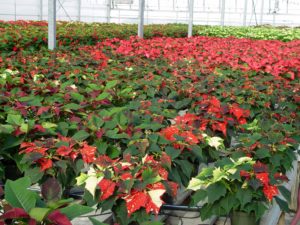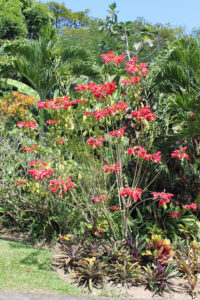How to Get Poinsettias to Color Back Up
February 6th, 2018
Poinsettias are impressive for holding their color well into winter and sometimes the whole way into spring.
They even make excellent foliage plants in a pot or garden outside in summer after the showy bracts drop to leave behind slimmer, tropical-looking, little green bushes.
The real trick is getting poinsettias to color back up again for a repeat winter show.
Poinsettias are fairly finicky about producing a new round of colorful bracts, needing a steady diet of about 14 hours of interrupted darkness every night for 8 to 10 weeks.
Mess up and you’ll still have a green bush next December – or one with a smattering of color that’s a far cry from what you bought a year ago.
Many people have tried the poinsettia-recycling routine, going so far as to pack their plant away in a closet every night to avoid stray light. They usually end up saying, “That’s the last time I’m going to go to that trouble. It’s easier just to buy a new one.”
Ah, but to an avid green-thumber, this is a challenge. If any old non-gardener can do something easily, that’s no fun. It’s the hard-to-do stuff that’s worth a go.
Want to try re-coloring a poinsettia rather than sending it to the compost pile? Here’s a how-to from the king of poinsettia producers, California’s Ecke Ranch.
1.) Continue to care for your poinsettia as you have been until late March or early April, i.e. near a bright window in damp but never soggy soil. At that point, cut the plant back to about 6 or 8 inches. It’ll look chopped and spindly at first, but by May, new growth should push out.
Fertilize during this time every two or three weeks with a balanced fertilizer or one with a breakdown of about 20-10-20. Keep the soil damp.
2.) When nighttime temperatures outside start rising above 55 degrees (usually mid to late May), gradually get the poinsettia used to being outside. Start with a few hours in the shade and then gradually increase the time and sunlight over 7 to 10 days.
At this point, you have two choices. Either repot the poinsettia in a slightly larger pot (consider making it part of a potted deck plant with annuals) or transplant it into a garden bed. A south-facing, protected area is ideal, but any area that gets at least 6 hours of good sunlight a day is fine (including a morning-sun/afternoon-shade location).
The plant won’t be in color during the summer, but the foliage and form make a nice focal point surrounded by summer flowers.
3.) During summer, pinch back any stems that are getting too long or lanky. Poinsettias want to turn into rather gangly tall bushes in their native habitat. Pinching or snipping them back to lower joints several times over summer makes them grower “bushier.”
Wear gloves so you don’t get the milky sap on your hands; some people get skin rashes from it.
Continue fertilizing monthly with a balanced or 20-10-20 fertilizer or every two weeks with the same product at half-strength.
Stop pinching by Sept. 1, and get the plant back inside at the first hint of below-55 temps… soon after Labor Day to be safe.
4.) By the third or fourth week of September, begin the all-important “response time,” which is grower talk for giving poinsettias the exact light-and-dark periods they need to trigger bract formation and coloration.
Poinsettias need complete darkness for 14 hours each night for 8 to 10 weeks in a row. Avoid both stray, consistent, low light and brief periods of sudden light. This is where at-home growers often resort to putting their poinsettias in a closet or covering them with a cardboard box every night.
Cut back fertilizer to half-strength, and stop fertilizing altogether by early to mid November.
After 8 to 10 weeks, the bracts should be coloring again and ready to go back on holiday display.
If you fail, at least you’ll have still have a compact green bush… and lots of new respect for greenhouse growers.









